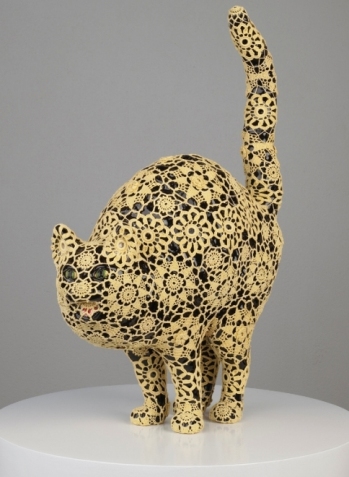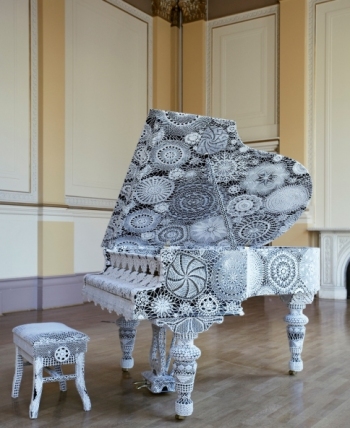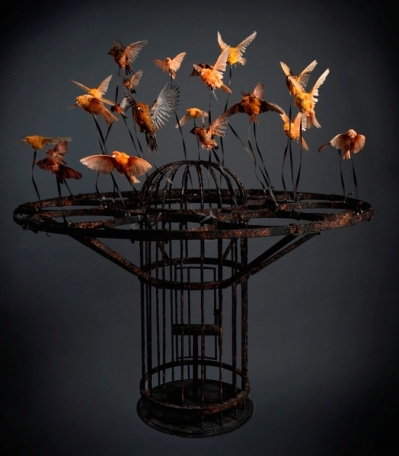Joana Vasconcelos/ Polly Morgan, Haunch of Venison | reviews, news & interviews
Joana Vasconcelos/ Polly Morgan, Haunch of Venison
Joana Vasconcelos/ Polly Morgan, Haunch of Venison
Two artists whose work manages to be both seductive and slightly creepy
The former Museum of Mankind, just behind the Royal Academy, has been the temporary home of the Haunch of Venison gallery for some two years. They’re moving back to their original home next spring, and though the newly extended building (Lord Nelson’s former residence at Haunch of Venison Yard, near Old Bond Street) is big and rather grand, the former museum is even bigger and grander. With neither longevity nor reputation to rely on, it’s a tough space for any young artist to fill. Still, if you think Portuguese artist Joana Vasconcelos might be better served in a tighter space, her first UK exhibition certainly proves her an artist worth looking out for.
 But that isn’t my first impression. Classical-style statues, encased in sleeves of crocheted fabric like elaborately decorative body-stockings, have been placed either side of the landing of the grand staircase – and these seem like pretty pointless “interventions” to me. But this is what Vasconcelos does. There are rooms and rooms filled with objects encased in lacy embroidery. Many of these are glazed ceramic animals, such as those you might find on any overstuffed mantelpiece. These, though, have been specially commissioned, beautifully crafted, and are a little oversized for decorative knick-knacks: a startled cat arching its back (pictured right); a giant bee seeming to rear up menacingly; giant lobsters and crabs in glistening shades of pink; a trio of frogs in a glass-fronted cabinet; a grand piano, looking like a huge wedding confection in its shroud of white lace (pictured below left).
But that isn’t my first impression. Classical-style statues, encased in sleeves of crocheted fabric like elaborately decorative body-stockings, have been placed either side of the landing of the grand staircase – and these seem like pretty pointless “interventions” to me. But this is what Vasconcelos does. There are rooms and rooms filled with objects encased in lacy embroidery. Many of these are glazed ceramic animals, such as those you might find on any overstuffed mantelpiece. These, though, have been specially commissioned, beautifully crafted, and are a little oversized for decorative knick-knacks: a startled cat arching its back (pictured right); a giant bee seeming to rear up menacingly; giant lobsters and crabs in glistening shades of pink; a trio of frogs in a glass-fronted cabinet; a grand piano, looking like a huge wedding confection in its shroud of white lace (pictured below left).
Presenting a parody of the zealously over-feminised home, these objects seem to comment on gender as well as class. And the colourful display becomes more engaging, humorous and unsettling as you proceed. It also becomes more elaborate and comically grotesque, with huge, fanciful creations made of stuffed knitted fabrics, such as the looming, black Victoria. This rather regal three-headed beast is apparently inspired by the mourning figure of Queen Victoria. With its wide girth and voluminous skirt, one can see where Vasconcelos is coming from.
 The theme of bondage is one that suggests itself throughout, but is overt in Esposas (Wives/Handcuffs). Six foam mannequins are bound by plastic spikes: three female figures, forming a circle on the floor, are shown tugging at three male figures as they appear to be trying to break free. Wearing its irony heavily, clunkily and rather literally, Esposas plays on the Spanish word for both married woman and handcuffs; it resembles a refugee artwork from some Seventies feminist art collective, and that certainly isn’t a good thing.
The theme of bondage is one that suggests itself throughout, but is overt in Esposas (Wives/Handcuffs). Six foam mannequins are bound by plastic spikes: three female figures, forming a circle on the floor, are shown tugging at three male figures as they appear to be trying to break free. Wearing its irony heavily, clunkily and rather literally, Esposas plays on the Spanish word for both married woman and handcuffs; it resembles a refugee artwork from some Seventies feminist art collective, and that certainly isn’t a good thing.
But nothing prepares you for the surprise and sheer delight of pulling back a curtain and encountering a hot-house nursery of artificial flowers, glowing with delicate pinpoints of light in the dark (main picture). As the flowers quiver, you can hear their motors faintly clicking, like a field of crickets. This immersive work is both eerie and beautiful.
 Polly Morgan, meanwhile, only has four works and one gallery to herself, in the mezzanine space. The fashionable taxidermist presents four unusual “chandeliers” which cast their looming shadows on the wall: a rusty and ornate birdcage is carried aloft by a dozen or so canaries (pictured right); two hanging globes are covered in outstretched pigeon wings; and a tiny bird nests inside an animal’s carcass, which is held afloat by a pageant of balloons.
Polly Morgan, meanwhile, only has four works and one gallery to herself, in the mezzanine space. The fashionable taxidermist presents four unusual “chandeliers” which cast their looming shadows on the wall: a rusty and ornate birdcage is carried aloft by a dozen or so canaries (pictured right); two hanging globes are covered in outstretched pigeon wings; and a tiny bird nests inside an animal’s carcass, which is held afloat by a pageant of balloons.
Morgan’s work is both exquisite and creepy, seductive and slightly repellent. One can’t help but be drawn to it.
- Joana Vasconcelos: I Will Survive/ Polly Morgan: Psychopomps at Haunch of Venison until 25 September
more Visual arts
 Stephen review - a breathtakingly good first feature by a multi-media artist
Melanie Manchot's debut is strikingly intelligent and compelling
Stephen review - a breathtakingly good first feature by a multi-media artist
Melanie Manchot's debut is strikingly intelligent and compelling
 Fantastic Machine review - photography's story from one camera to 45 billion
Love it or hate it, the photographic image has ensnared us all
Fantastic Machine review - photography's story from one camera to 45 billion
Love it or hate it, the photographic image has ensnared us all
 Yinka Shonibare: Suspended States, Serpentine Gallery review - pure delight
Weighty subject matter treated with the lightest of touch
Yinka Shonibare: Suspended States, Serpentine Gallery review - pure delight
Weighty subject matter treated with the lightest of touch
 Jane Harris: Ellipse, Frac Nouvelle-Aquitaine MÉCA, Bordeaux review - ovals to the fore
Persistence and conviction in the works of the late English painter
Jane Harris: Ellipse, Frac Nouvelle-Aquitaine MÉCA, Bordeaux review - ovals to the fore
Persistence and conviction in the works of the late English painter
 Sargent and Fashion, Tate Britain review - portraiture as a performance
London’s elite posing dressed up to the nines
Sargent and Fashion, Tate Britain review - portraiture as a performance
London’s elite posing dressed up to the nines
 Zineb Sedira: Dreams Have No Titles, Whitechapel Gallery review - a disorientating mix of fact and fiction
An exhibition that begs the question 'What and where is home?'
Zineb Sedira: Dreams Have No Titles, Whitechapel Gallery review - a disorientating mix of fact and fiction
An exhibition that begs the question 'What and where is home?'
 Yoko Ono: Music of the Mind, Tate Modern review - a fitting celebration of the early years
Acknowledgement as a major avant garde artist comes at 90
Yoko Ono: Music of the Mind, Tate Modern review - a fitting celebration of the early years
Acknowledgement as a major avant garde artist comes at 90
 Unravel: The Power and Politics of Textiles in Art, Barbican review - the fabric of dissent
An ambitious exploration of a neglected medium
Unravel: The Power and Politics of Textiles in Art, Barbican review - the fabric of dissent
An ambitious exploration of a neglected medium
 When Forms Come Alive, Hayward Gallery review - how to reduce good art to family fun
Seriously good sculptures presented as little more than playthings or jokes
When Forms Come Alive, Hayward Gallery review - how to reduce good art to family fun
Seriously good sculptures presented as little more than playthings or jokes
 Entangled Pasts 1768-now, Royal Academy review - an institution exploring its racist past
After a long, slow journey from invisibility to agency, black people finally get a look in
Entangled Pasts 1768-now, Royal Academy review - an institution exploring its racist past
After a long, slow journey from invisibility to agency, black people finally get a look in
 Barbara Kruger, Serpentine Gallery review - clever, funny and chilling installations
Exploring the lies, deceptions and hyperbole used to cajole, bully and manipulate us
Barbara Kruger, Serpentine Gallery review - clever, funny and chilling installations
Exploring the lies, deceptions and hyperbole used to cajole, bully and manipulate us
 Richard Dorment: Warhol After Warhol review - beyond criticism
A venerable art critic reflects on the darkest hearts of our aesthetic market
Richard Dorment: Warhol After Warhol review - beyond criticism
A venerable art critic reflects on the darkest hearts of our aesthetic market

Add comment